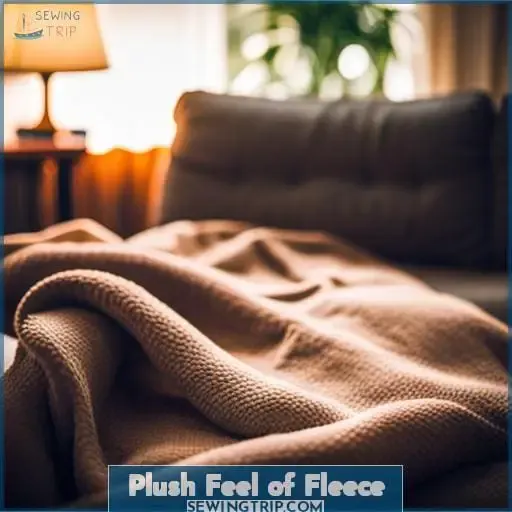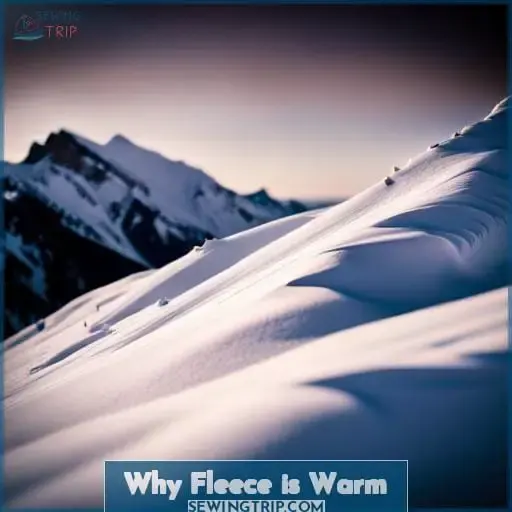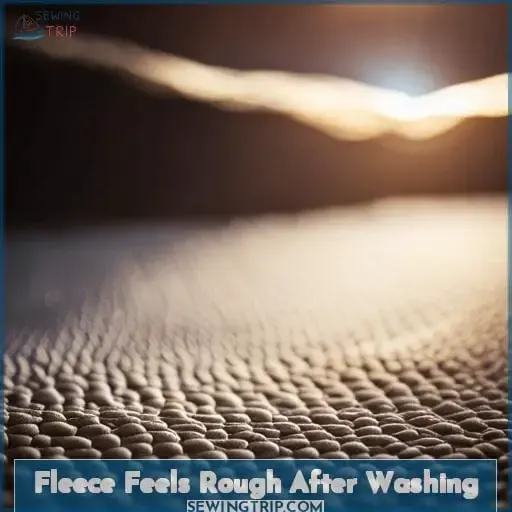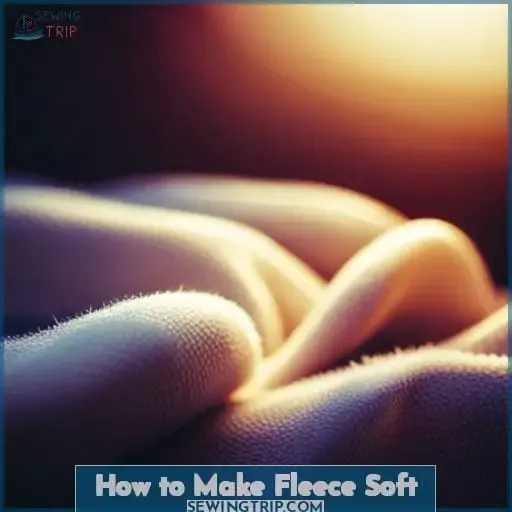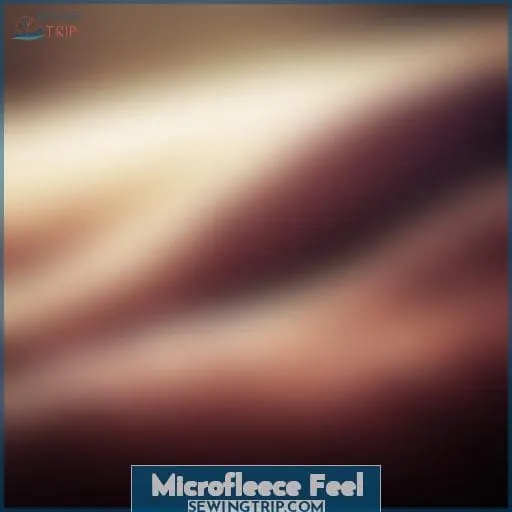This site is supported by our readers. We may earn a commission, at no cost to you, if you purchase through links.
 In a world where softness and warmth intertwine,
In a world where softness and warmth intertwine,
there exists a fabric that embodies comfort like no other: fleece.
From the moment it graces your skin,
a sensation of plushness envelops you,
inviting you to surrender to its gentle embrace.
Its lightweight nature defies logic,
as though it were a cloud that drapes you in coziness
without burdening you.
Fleece, a symphony of texture and warmth,
beckons you to experience the ultimate in comfort and style.
Table Of Contents
Key Takeaways
- Plush, soft texture for comfort and warmth
- Lightweight and breathable for easy layering
- Traps body heat thanks to air pocket insulation
- Mimics wool’s softness at an affordable price point
Plush Feel of Fleece
With fleece surrounding you, its plush softness is instantly noticeable.
The heavenly plush comfort of fleece caresses your skin with a featherlight touch.
This lightweight luxury blankets you in soft warmth and cozy texture without the burden of bulky fabrics.
As you lounge wrapped in fleece’s gentle embrace, you’ll find its softness as soothing as a fluffy cloud that breathes with your body.
The fleece sensation glides smoothly across your skin, providing a light yet substantial fabric that moves with you.
Its cloud-like plush texture surrounds you in breathable softness that feels like a warm hug.
Fleece gives you the best of both worlds – plush comfort with lightweight practicality for all-day wear.
Why Fleece is Warm
Fleece keeps you nice and toasty because the fabric’s air pockets trap your body heat close to your skin.
The material also wicks moisture away from your body rather than absorbing it, which helps maintain that insulating layer of warmth.
With fleece, you get a soft, plush fabric that magically makes you feel like you’re wrapped in a soothing, warming hug.
Air Pockets Trap Heat
You will feel warm when wearing fleece because the fabric’s air pockets trap your body heat close to your skin.
The plush, lightweight fleece surrounds you in a cozy insulating layer of trapped air that provides excellent thermal comfort.
This clever trapping fabric uses its soft yet heat-retaining air pocket insulation to seal in your natural warmth.
Fleece’s ingenious air pocket technology is key to its reputation for delivering lightweight, plush warmth and that snuggly, heat-trapping fabric feel.
Wicks Moisture
Fleece wicks away moisture and doesn’t absorb much, keeping you warmer.
Moisture-wicking magic allows fleece to keep dampness at bay.
Breathable comfort comes from fleece’s ability to whisk moisture away.
Hygroscopic fleece defends against dampness for cozy warmth.
Dampness defense is fleece’s superpower thanks to moisture management.
Plush, lightweight fleece fabric wicks moisture rapidly for quick drying and no pilling.
Polyester Fleece Feel
Polyester fleece feels similar to other fleece types in its plush and soft comfort, though its breathability and warmth vary with fabric thickness and material quality.
Here is a comparison of polyester fleece properties at different thicknesses:
| Fleece Thickness | Softness | Breathability | Warmth |
|---|---|---|---|
| Lightweight | Less plush | More breathable | Less insulating |
| Mid-weight | Medium plush | Medium breathability | Medium warmth |
| Heavy-weight | Very plush | Less breathable | Warmer |
The plush feel is most prominent in thick polyester fleece blankets.
Lightweight polyester fleece works well for activewear since it wicks moisture yet doesn’t overheat.
Those with sensitivities may react to polyester, so sustainable fleece options like recycled plastic bottles bring the coziness without the allergies.
Overall, polyester fleece balances soft comfort and lightweight practicality.
Polar Fleece Feel
Polar fleece feels thin and soft, mimicking the feel of real wool from sheep. It’s a lightweight yet warming fabric with a mimicked wool feel and plushness.
Polar fleece provides comfort for sportswear like sweatpants without sacrificing warmth.
The fleece blankets act as a cheaper substitute for pricey winter bedding to envelope you. As an affordable blanket option, it brings the coziness of thicker fleeces without the high expense.
Fleece Blanket Feel
For the hibernal bliss of blanketing yourself in soft comfort,
fleece blankets wrap you in soothing, plush warmth.
The lofty thickness happily traps heat for cozy winter snuggling.
Light as a feather yet insulating as a cloud,
fleece blanketing brings on blanket euphoria.
Through frigid nights, fleece blankets keep you cozy warm
thanks to their soft texture and ability to maintain body heat.
That plush handfeel brings on blissful relaxation
while you drift off to sleep enveloped in lightweight warmth.
Fleece blankets give you the gift of serene snuggling
through harsh wintery nights.
Their softness and insulation deliver true blanket bliss.
Does Fleece Itch?
Your fleece garment shouldn’t give you an itchy feeling or irritation on your skin.
The plush, soft fibers create a soothing texture against your body.
While preferences vary, fleece is designed for comfort.
The lightweight fabric should feel gentle with no scratchy or prickly sensations.
Of course, some may dislike certain textures.
But quality fleece eliminates the itch factor.
The smooth finish and brushed nap keep you cozy without any skin discomfort.
With natural fibers like cotton or synthetic polyester, fleece maintains its soft hand.
This allows freedom of movement without irritation.
So you can stay active while wrapped in the plush warmth of fleece.
Any itching likely signals an issue with that specific garment, not the fabric itself.
Properly crafted fleece soothes rather than scratches.
Fleece Feels Rough After Washing
One can easily ruin fleece’s plush softness through incorrect laundering methods.
As your trusted fabric expert, I want to ensure your fleece maintains its comforting texture.
Fleece made from polyester or cotton blends feels rough and scratchy when washed in hot water or dried using high heat.
To keep fleece feeling gently plush, use cold water on a gentle cycle with a small amount of mild detergent.
Skip fabric softeners and dryer sheets as they leave residue.
Instead, dry flat or on low.
With some care when laundering, your fleece textiles will retain their cozy, plushy texture that we crave in the colder months.
Implementing these simple tips preserves the welcoming feel we love fleece for, letting us wrap ourselves in gentle warmth.
How to Make Fleece Soft
- You can make fleece soft again by washing it in cold water with a liquid detergent, skipping the dryer sheets, and either hang-drying it or using a gentle, low-heat cycle in the dryer.
- Feel the plushness melt away as abrasive laundry products damage the fibers’ protective oils.
- Watch your treasured fleece blanket emerge from the wash rough and matted.
- Experience the loss when your favorite joggers lose their cushioned texture.
- Get conflicting advice on internet forums that leaves you even more confused.
- To restore fleece’s beloved lightweight warmth:
- Use a gentle cleanser, skip the dryer sheets.
- Rinse thoroughly, hang to dry or tumble on low.
- Soon you’ll be cradled in downy softness once more.
- We help recapture what fleece does best – wrap you in cozy cloud-like comfort.
- Let’s walk you through proper care for sensuous fabrics you’ll love wearing every day.
Microfleece Feel
Microfleece is known for its super soft and lightweight feel, making it a popular choice among those seeking warmth without bulk.
Its plush texture provides comfort and coziness against the skin, while its lightweight nature allows for ease of movement.
Whether used in blankets, clothing, or accessories, microfleece offers a luxurious feel that combines warmth with breathability.
Super Soft
You’ll find microfleece has an incredibly soft feel thanks to its lightweight, thin construction that still provides warmth.
Experience the super snuggly, cozy comfort of its plush perfection paired with lightweight warmth.
Revel in microfleece’s soft embrace and gentle texture, like a warm hug wrapped in lightweight luxury.
Snuggle into the cuddly bliss and featherlight softness of this modern fleece iteration.
Lightweight Warmth
You’re feeling incredibly warm yet lightweight when wearing microfleece.
As the thinnest and softest type of fleece, it excels at providing warmth without the bulk.
It offers a snuggly coziness rivaled by few fabrics with its:
- Velvety texture
- Breathable insulation
- Wind-blocking abilities
The lightweight microfleece strands trap heat in a pleasantly plush way that keeps you toasty when braving the cold winter air.
It’s the ultimate soft and cozy fleece.
How is Fleece Fabric Made?
After feeling the soft coziness of microfleece, you may wonder how this delightful fabric comes into existence.
Fleece begins its life when polymers such as polyester or polymers blended with natural fibers are spun into yarns. These yarns are then knit or woven into fleeces of varying weights and thicknesses.
During finishing, one or both sides are brushed to raise the fibers and create that plush, cushy feel we love.
The brushing process gives fleece its signature gentle texture.
Modern options like eco-friendly, recycled fabrics prove fleece can also be kind to the planet while keeping you comfy.
- Knitting or weaving polymers into base fabrics
- Finishing with mechanical brushes
- Creating single-sided plush fleece or double-sided super plush
Frequently Asked Questions (FAQs)
Does fleece shrink when washed?
Yes, fleece can shrink if washed in hot water and dried in a hot dryer.
To prevent shrinking, wash fleece in cold water with a mild detergent using the gentle or delicate cycle.
Air dry or tumble dry on low heat.
These easy care instructions will maintain fleece’s softness and size.
Is fleece good for people with sensitive skin?
Fleece comfort depends on you.
Some softer types may work with sensitive skin if high quality, while cheaper fleece could irritate.
Test different wicks and weights, like smooth microfleece or plush sherpa.
Focus on natural fibers and gentle cycles.
Finding the right match helps you feel cozy.
How does fleece compare to wool in terms of warmth?
Fleece cradles you like a gentle lamb,
Enveloping you in plush softness,
While wool wraps you in its rough though hardy embrace.
Fleece may comfort,
Yet wool guards against winter’s bite.
For the frigid days,
Choose wool’s battle-tested warmth;
When milder,
Fleece’s soft caress suffices.
Does fleece pill over time and look worn out?
Yes, fleece does tend to pill and look worn over time.
Proper care, like washing in cold water, air drying, and using a fabric shaver, can help maintain its soft texture longer.
Still, the nature of fleece is to pill eventually.
Is fleece breathable enough to wear in warm weather climates?
As fleece keeps air pockets for warmth, you’ll sweat in hot temperatures.
Opt for breezier fabrics like linen or cotton in warm climates.
Conclusion
Excuse the lengthy discourse, my dear, but you see,
The divine blessing fleece bequeaths
Is a singular warmth and comfort
No other textile can impart.
Its plush feel delights the skin
While its lightweight air pockets ensconce you.
Indeed, synthetic fibers have their place,
But fleece, with its soft hand and cozy warmth,
Is peerless; try it yourself
And I promise you’ll be seduced
By fleece’s snug embrace.
Now go, thrive in fleece’s fuzzy comforts –
You deserve nothing less, darling.

